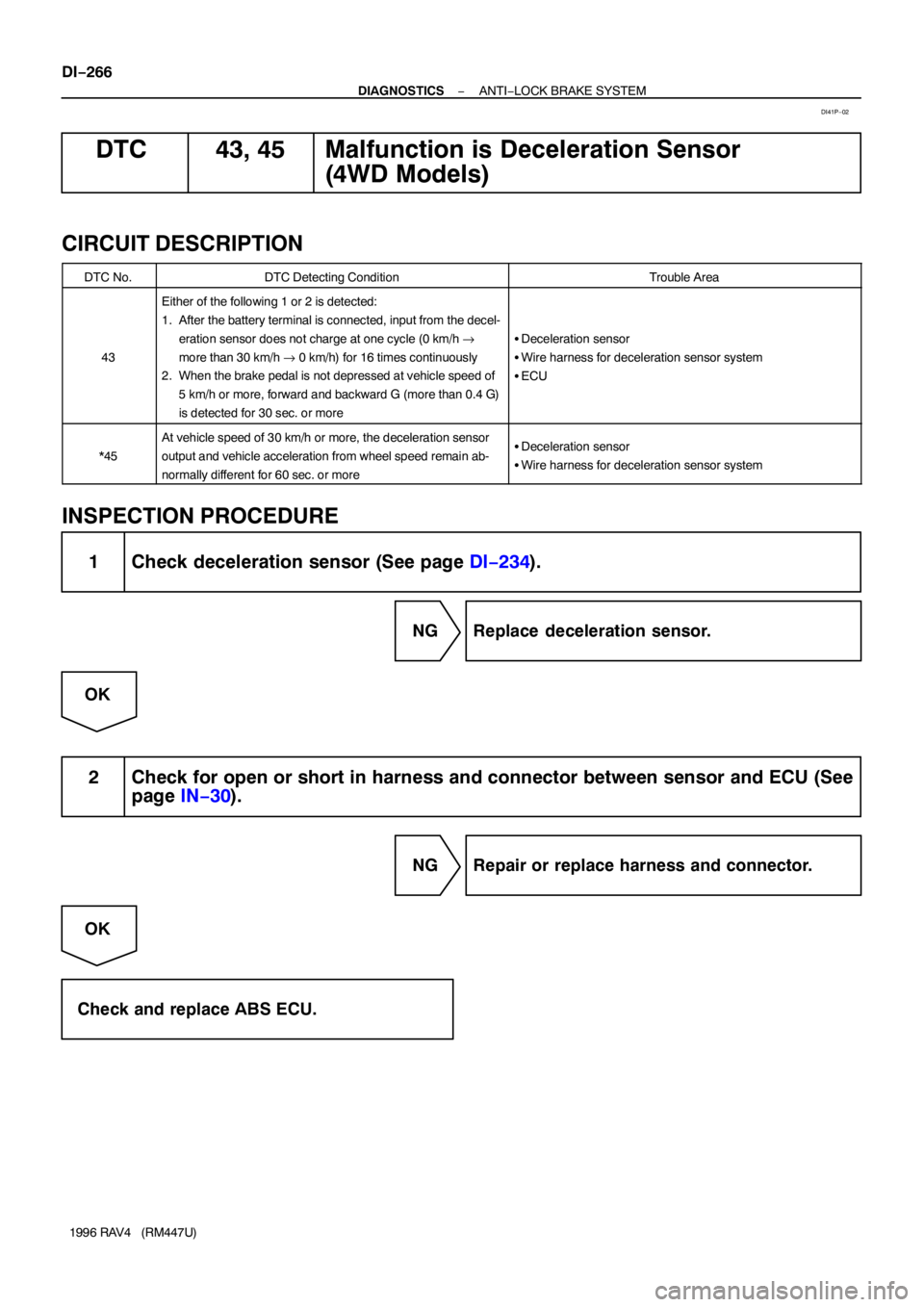Page 573 of 1354
F04137
A8A9
A8A9
(−) (+)1
3 2
42
4
31
− DIAGNOSTICSANTI−LOCK BRAKE SYSTEM
DI−253
1996 RAV4 (RM447U)
3 Check ABS control (motor) relay.
CHECK:
Check the continuity between each terminal of the ABS control
relay.
OK:
Terminals A8−3 and A8−4Continuity
(Reference value 68 Ω)
Terminals A8−1 and A8−2Open
CHECK:
(a) Apply battery voltage between terminals A8−3 and A8−4.
(b) Check the continuity between terminal of the ABS control
relay.
OK:
Terminals A8−1 and A8−2Continuity
NG Replace ABS control relay.
OK
4 Check for open and short in harness and connector between ABS control relay
and ABS ECU (See page IN−30).
NG Repair or replace harness or connector.
OK
If same code is still output after DTC is deleted, check contact condition of each connection. If
connections are normal, ECU may be defective.
Page 576 of 1354
W00714
8
7
651 2
3
4
4
A7
A6
DI−256
− DIAGNOSTICSANTI−LOCK BRAKE SYSTEM
1996 RAV4 (RM447U)
INSPECTION PROCEDURE
1 Check ABS actuator solenoid.
PREPARATION:
Disconnect the 2 connectors from the ABS actuator.
CHECK:
Check the continuity between terminals A7−4 and A6−1, 2, 3,
4, 5, 6, 7, 8 of the ABS actuator connector.
OK:
Continuity
HINT:
�Resistance of each of the solenoids SFRH, SFLH, SRRH
and SRLH is 5.0 Ω (4WD models) or 8.8 Ω (2WD models).
�Resistance of each of the solenoids SFRR, SFLR, SRRR
and SRLR is 2.2 Ω (4WD models) or 4.3 Ω (2WD models).
NG Replace ABS actuator.
OK
2 Check for open and short in harness and connector between ABS ECU and ac-
tuator (See page IN−30).
NG Repair or replace harness or connector.
OK
If same code is still output after DTC is deleted, check contact condition of each connection. If
connections are normal, ECU may be defective.
Page 586 of 1354

DI−266
− DIAGNOSTICSANTI−LOCK BRAKE SYSTEM
1996 RAV4 (RM447U)
DTC 43, 45 Malfunction is Deceleration Sensor
(4WD Models)
CIRCUIT DESCRIPTION
DTC No.DTC Detecting ConditionTrouble Area
43
Either of the following 1 or 2 is detected:
1. After the battery terminal is connected, input from the decel-
eration sensor does not charge at one cycle (0 km/h →
more than 30 km/h → 0 km/h) for 16 times continuously
2. When the brake pedal is not depressed at vehicle speed of
5 km/h or more, forward and backward G (more than 0.4 G)
is detected for 30 sec. or more
�Deceleration sensor
�Wire harness for deceleration sensor system
�ECU
*45
At vehicle speed of 30 km/h or more, the deceleration sensor
output and vehicle acceleration from wheel speed remain ab-
normally different for 60 sec. or more�Deceleration sensor
�Wire harness for deceleration sensor system
INSPECTION PROCEDURE
1 Check deceleration sensor (See page DI−234).
NG Replace deceleration sensor.
OK
2 Check for open or short in harness and connector between sensor and ECU (See
page IN−30).
NG Repair or replace harness and connector.
OK
Check and replace ABS ECU.
DI41P−02
Page 587 of 1354
W01940
− DIAGNOSTICSANTI−LOCK BRAKE SYSTEM
DI−267
1996 RAV4 (RM447U)
DTC 44 Deceleration Sensor Circuit (4WD Models)
CIRCUIT DESCRIPTION
This sensor detects deceleration on the vehicle. The sensor signal is used in ABS control. If the sensor func-
tions abnormally, the ABS warning light comes on but the ABS still operates.
DTC No.TC Detecting ConditionTrouble Area
44
Either of the following 1 or 2 is detected:
1. G switch ON and output voltage of GL1 or GL2 remains 0.5
V or less or 4.5 V or more for more than 1.2 sec.
2. At vehicle speed of 0 km/h, outputs of GL1 and of GL2 re-
mains abnormally different for 60 sec. or more
3. IG switch ON and VGS � 4.4 V, VGS � 5.5 V continues
for 1.2 sec. or more
�Deceleration sensor
�Open or short in deceleration sensor circuit
�ECU
WIRING DIAGRAM
INSPECTION PROCEDURE
1 Check for open and short in harness and connector between sensor and ECU
(See page IN−30).
NG Repair or replace harness or connector.
OK
DI98Y−01
Page 667 of 1354

EM0EG−02
S01353
CO/HC Meter
− ENGINE MECHANICALCO/HC
EM−1
1996 RAV4 (RM447U)
CO/HC
INSPECTION
HINT:
This check is used only to determine whether or not the idle CO/
HC complies with regulations.
1. INITIAL CONDITIONS
(a) Engine at normal operating temperature
(b) Air cleaner installed
(c) All pipes and hoses of air induction system connected
(d) All accessories switched OFF
(e) All vacuum lines properly connected
HINT:
All vacuum hoses for EGR systems, etc. should be properly
connected.
(f) SFI system wiring connectors fully plugged
(g) Ignition timing check correctly
(h) Transmission in neutral position
(i) Tachometer and CO/HC meter calibrated by hand.
2. START ENGINE
3. RACE ENGINE AT 2,500 RPM FOR APPROX. 180 SE-
CONDS
4. INSERT CO/HC METER TESTING PROBE AT LEAST
40 cm (1.3 ft) INTO TAILPIPE DURING IDLING
5. IMMEDIATELY CHECK CO/HC CONCENTRATION AT
IDLE AND/OR 2,500 RPM
Complete the measuring within 3 minutes.
HINT:
When performing the 2 mode (2,500 rpm and idle) test, follow
the measurement order prescribed by the applicable local regu-
lations.
Page 678 of 1354
EM0EK−01
EM−12
− ENGINE MECHANICALIDLE SPEED
1996 RAV4 (RM447U)
IDLE SPEED
INSPECTION
1. INITIAL CONDITIONS
(a) Engine at normal operating temperature
(b) Air cleaner installed
(c) All pipes and hoses of air induction system connected
(d) All vacuum lines properly connected
(e) SFI system wiring connectors fully plugged
(f) All operating accessories switched OFF
(g) Ignition timing check correctly
(h) Transmission in neutral position
(i) Air conditioning switched OFF
2. CONNECT TOYOTA HAND−HELD TESTER OR OBD II SCAN TOOL (See page EM−11)
3. INSPECT IDLE SPEED
(a) Race the engine speed at 2,500 rpm for approx. 90 seconds.
(b) Check the idle speed.
Idle speed (w/ Cooling fan OFF): 750 ± 50 rpm
If the idle speed is not as specified, check the IAC valve and air intake system.
4. DISCONNECT TOYOTA HAND−HELD TESTER OR OBD II SCAN TOOL
Page 785 of 1354
15
ABBREVIATIONS D
ABBREVIATIONS
The following abbreviations are used in this manual.
ABS = Anti-Lock Brake System
A/C = Air Conditioning
A/T = Automatic Transaxle
COMB. = Combination
DIFF. = Differential
ECU = Electronic Control Unit
EGR = Exhaust Gas Recirculation
EVAP = Evaporative Emission
J/B = Junction Block
LH = Left-Hand
M/T = Manual Transaxle
O/D = Overdrive
R/B = Relay Block
RH = Right-Hand
SFI = Sequential Multiport Fuel Injection
SRS = Supplemental Restraint System
SW = Switch
TEMP. = Temperature
VSV = Vacuum Switching Valve
w/ = With
w/o = Without
2WD = Two Wheel Drive
4WD = Four Wheel Drive
* The titles given inside the components are the names of the terminals (terminal codes) and are not
treated as being abbreviations.
Page 834 of 1354

65
2. CONTROL SYSTEM
*SFI
THE SFI SYSTEM MONITORS THE ENGINE CONDITION THROUGH THE SIGNALS, WHICH ARE INPUT FROM EACH SENSOR (INPUT
SIGNALS (1) TO (11)). THE BEST FUEL INJECTION VOLUME IS DECIDED BASED ON THIS DATA AND THE PROGRAM MEMORIZED
BY THE ENGINE CONTROL MODULE, AND THE CONTROL SIGNAL IS OUTPUT TO TERMINALS #10, #20, #30, AND #40 OF THE
ENGINE CONTROL MODULE TO OPERATE THE INJECTOR (INJECT THE FUEL). THE SFI SYSTEM PRODUCES CONTROL OF FUEL
INJECTION OPERATION BY THE ENGINE CONTROL MODULE IN RESPONSE TO THE DRIVING CONDITIONS.
*IDLE SPEED CONTROL SYSTEM
THE IDLE SPEED CONTROL SYSTEM INCREASES THE RPM AND PROVIDES IDLING STABILITY FOR FAST IDLE-UP WHEN THE
ENGINE IS COLD AND WHEN THE IDLE SPEED HAS DROPPED DUE TO ELECTRICAL LOAD, ETC. THE ENGINE CONTROL MODULE
EVALUATES THE SIGNALS FROM EACH SENSOR (INPUT SIGNALS (1 TO 5, 11), OUTPUTS CURRENT TO TERMINAL ISCO AND ISCC,
AND CONTROLS THE IDLE AIR CONTROL VALVE.
*A/C CUT CONTROL SYSTEM
WHEN THE VEHICLE SUDDENLY ACCELERATES FROM LOW ENGINE SPEED, THIS SYSTEM CUTS OFF AIR CONDITIONING
OPERATION FOR A FIXED PERIOD OF TIME IN RESPONSE TO THE SPEED SENSOR, THROTTLE VALVE OPENING ANGLE AND
INTAKE MANIFOLD PRESSURE IN ORDER TO MAINTAIN ACCELERATION PERFORMANCE.
THE ENGINE CONTROL MODULE RECEIVES INPUT SIGNALS (4, 5 AND 9), AND INPUTS SIGNALS TO TERMINAL ACT.
3. DIAGNOSIS SYSTEM
WITH THE DIAGNOSIS SYSTEM, WHEN THERE IS A MALFUNCTION IN THE ENGINE CONTROL MODULE SIGNAL SYSTEM, THE
MALFUNCTIONING SYSTEM IS RECORDED IN THE MEMORY. THE MALFUNCTIONING SYSTEM CAN THEN BE FOUND BY READING
THE DISPLAY (CODE) OF THE MALFUNCTION INDICATOR LAMP.
4. FAIL-SAFE SYSTEM
WHEN A MALFUNCTION OCCURS ON ANY SYSTEM, IF THERE IS A POSSIBILITY OF ENGINE THROUBLE BEING CAUSED BY
CONTINUED CONTROL BASED IN THE SIGNALS FROM THAT SYSTEM, THE FAIL-SAFE SYSTEM EITHER CONTROLS THE SYSTEM BY
USING DATA (STANDARD VALUES) RECORDED IN THE ENGINE CONTROL MODULE MEMORY OR ELSE STOPS THE ENGINE.